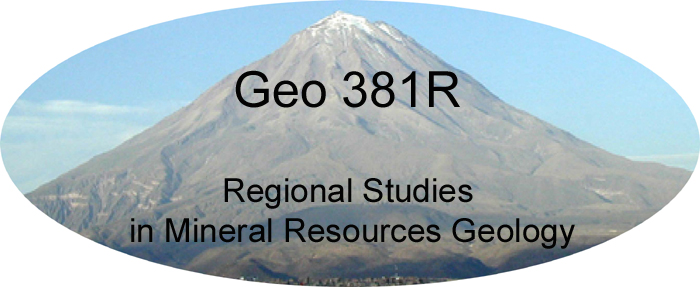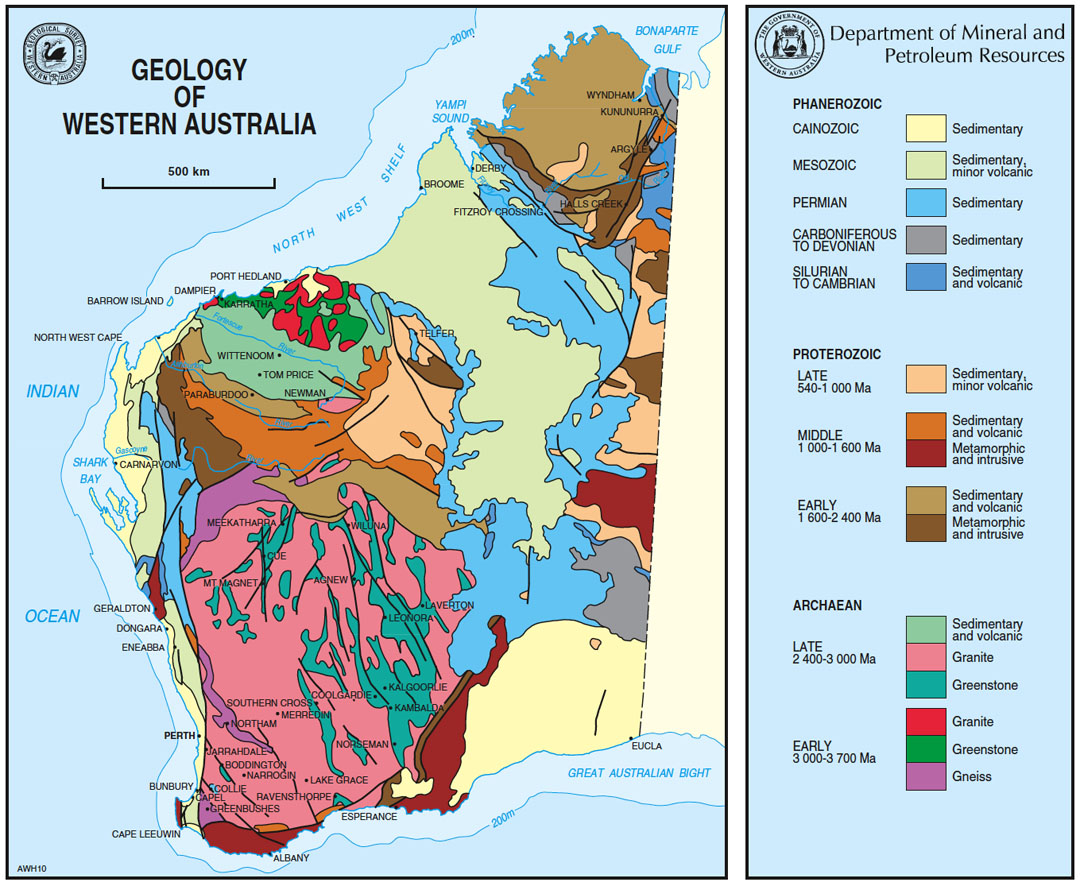
GEO 381R Field Excursion to Western Australia
The
2003 offering of GEO 381R was taught by Rich Kyle and Sharon Mosher and focused
on the Geologic Evolution and Mineral Resource
Development of Western Australia.
The
course culminated in a three-week trip to Western Australia in May 2003 that
provided an exceptional educational opportunity for 12 UT graduate students with
diverse interests to study many classic geologic sites. Western Australia offers an excellent 381R destination,
as it has varied geologic environments and is one of the worlds major mineral
producers. The Geology
Foundation provided scholarships to help cover the international airfare for the
students. Other costs were kept low
by camping for most of the trip.
This trip represented a return visit for a trip
that Sharon organized for a group of University of Western Australia graduate
students and faculty three years ago. Annette
George, Senior Lecturer in Sedimentology
& Basin Analysis at UWA, organized and led most of the trip, along with other UWA
colleagues and local authorities. The
trip began and ended in Perth and consisted of a
6,800-km clockwise traverse through a large part of Western Australia.
Following
a day for travel recovery and trip organization, the caravan headed north along
the Western Australia coast to Kalbarri with the first stop to look at the
Ordovician Tumblagooda sandstone and its trace fossils at Red Bluff.
The next day started with similar exposures along the Z-bend of the
Murchison River in Kalbarri National Park, followed by a long drive to arrive
near dusk at low tide at the world famous modern stromatolites at Hamelin Pool
at Shark Bay. The next morning
provided an even more intimate experience with stromatolites and related
sediments at the Carbla
Point.
After
night in Carnavon and a dust storm along the coast, the group turned toward the
interior to begin a several day tour of the Hamersley Basin, known for its
extensive banded iron formations that supply much of the worlds iron for the
steel industry. The origin of these unusual sedimentary rocks remains
controversial, but commonly is tied to the evolution of the early Earth
atmosphere, hydrosphere, and biosphere. Extensive
exposures of the Hamersley Group were provided by traverses near Woongarra Pool,
the gorges in Karinjini National Park, and on Mt. Nameless (Jarndunmunha).
The group later toured the commercial iron concentrations developed from
the BIFs at BHPs Mt.
Whaleback mine
near Newman that produces about 80 million tonnes of iron ore per year.
The
next major site was the Marble Bar and North Pole regions of the Archean Pilbara
Craton. The region represents one
of the worlds oldest greenstone-granite terranes with classic structural
styles, but of particular current interest are the silica- and barite-rich
chemical sediments on which much research continues in the search for early life
on Earth. These include the
controversial stromatolites in dolostones at the North Pole dome that are
arguably the Earths oldest biogenic structures.
Martin Van Kranendonk of the Geological Survey of Western Australia and
Malcolm Walter, Director of the Australian Centre for Astrobiology, and graduate
students from Macquarie University shared their extensive knowledge of the
geology of the region and on the early life issues.
Travels through the outback on the primitive tracks to view these
features provided considerable challenges for the rental minivan and the skills
of the driver!
The
group headed south to Newman, where Rich departed for the Geological Association
of Canada meeting in Vancouver and Annette returned to Perth for teaching
obligations. Warrick Crowe of the University of Western Australia guided the
group for the remainder of the tour. The
caravan continued with a long drive south to Kalgoorlie, one of the worlds
most famous gold mining regions within the Archean Yilgarn Craton, for a several
day visit. Kevin Cassidy of Geoscience Australia gave us an excellent overview
of the Yilgarn Craton and took us on a field excursion to see the Mt. Hunt
komatiite-felsic volcanic sequence; we were fortunate to have several other
geologists join us including Bruce Groenewald from the Western Australia Survey
and Chris Swager from a local mining company.
In contrast to the well-exposed Pilbara Craton, the Yilgarn is best
exposed in the mines or drill core. We
visited the gold mine superpit in Kalgoorlie and had a fascinating underground mine
tour of
a komatiite-hosted nickel-sulfide deposit in Kambalda, plus viewed core at the
mine and at the Geological Survey of Western Australia core library. A visit to the Mining Hall of Fame was gave us a good
historical perspective on mining in Western Australia.
The group next drove to the southern coast to see some superb exposures
of the Grenville-age Albany-Fraser belt. Warwick
Crowe led us along white sand beaches and rocky coves to spectacular structures
in multiply folded pelites at Hopetown and high-grade gneisses at Bremer
Bay. As we headed towards
Perth along the southern coast, we visited the Greenbushes pegmatite mine, a
major tantalum producer and high-grade lithium resource. On our last day we
drove to Perth with a brief tourist stop at Margaret River.
The trip to Western Australia was a great geoadventure and learning
experience, and we are grateful for the support of the School of Earth &
Geographical Sciences at the University of Western Australia, particularly
Annette George who converted our diverse interests into a working travel plan.
Discussions are already underway about destinations for the next
international field excursion.
Modified from story by Rich Kyle and Sharon Mosher in the 2003 DGS Newsletter
Photo
1. Domal stromatolites in the Shark
Bay intertidal zone at Carbla Point, Western Australia.
Photo
2. Dawn at the GEO 381R campsite at Woongarra Pool in the Hamersley Basin.
Steeply dipping banded iron formations in the background.
Photo
3. Mt. Whaleback open pit iron mine
at Newman, Western Australia.
Photo
4. GEO 381R field trip group
prepared to go on the underground tour at the komatiite-hosted nickel mine at
Kambalda, Western Australia.
Photo 5. Large scale boudins in high grade gneisses of the Grenville-age Albany-Fraser belt at Bremer Bay, Western Australia.

 |
||
|
|| Home || Introduction || Syllabus || Spring '09 trip description || Canada Travel || Sources || Related Sites || Chile 1999 || Peru 2000 || Spain - Portugal 2001 || |
||